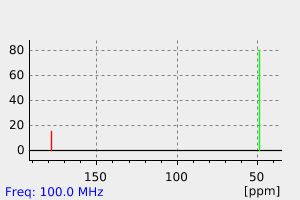1,3-二氧代丙烷-1,3-二酮 | 156-80-9
物质功能分类
中文名称
1,3-二氧代丙烷-1,3-二酮
中文别名
甜菜酸;缩苹果酸;胡萝卜酸;丙二酸根;丙烷二羧酸;甲烷二羧酸;丙二酸
英文名称
malonate
英文别名
malonate anion;malonate dianion;1,3-propanedioate;propanedioate
CAS
156-80-9
化学式
C3H2O4
mdl
——
分子量
102.046
InChiKey
OFOBLEOULBTSOW-UHFFFAOYSA-L
BEILSTEIN
——
EINECS
——
-
物化性质
-
计算性质
-
ADMET
-
安全信息
-
SDS
-
制备方法与用途
-
上下游信息
-
文献信息
-
表征谱图
-
同类化合物
-
相关功能分类
-
相关结构分类
物化性质
-
熔点:135 dec °C
-
溶解度:763000 mg/L (at 25 °C)
计算性质
-
辛醇/水分配系数(LogP):0.8
-
重原子数:7
-
可旋转键数:0
-
环数:0.0
-
sp3杂化的碳原子比例:0.33
-
拓扑面积:80.3
-
氢给体数:0
-
氢受体数:4
SDS
反应信息
-
作为反应物:描述:1,3-二氧代丙烷-1,3-二酮 在 D-阿拉伯糖 、 异丙基-beta-D-硫代半乳糖吡喃糖苷 作用下, 以 aq. phosphate buffer 为溶剂, 反应 16.0h, 生成 3-羟基丙酸参考文献:名称:在基因改造的大肠杆菌菌株中使用新型丙二酰辅酶A介导的生物合成途径生产3-羟基丙酸酯†摘要:3-羟基丙酸(3-HP)是一种有前途的平台化学品,具有广泛的应用范围。3-HP的传统化学合成方法已经确立,但是所用原料的资源限制,价格昂贵和毒性不符合新的可持续发展目标。因此,主要由于其环境友好的生产,可再生资源的利用和可持续发展,通过发酵微生物合成3-HP将成为一种有前途和有吸引力的途径。在此,为了直接从丙二酸酯生物合成3-HP,成功开发了如下的新丙二酰-CoA介导的生物合成途径。首先,对涉及丙二酸运输的各种运输工具进行了系统的研究和筛选。其次,要生物合成3-HP,Chloroflexus子囊菌从和丙二酰-CoA合成酶(MATB)沼泽红假单胞菌在大肠杆菌C43(DE3)株,将其从三个不同的MATB酶筛选。最后,为了进一步提高3-HP的产量,表达天然的转氢酶(PntAB)和NAD激酶(YfjB)基因以增加大肠杆菌中NADPH的供应。最终的基因改造菌株SGN78在丙二酸利用方面显示出显着改善,并在烧瓶培养物中产生了1DOI:10.1039/c9gc02286d
-
作为产物:描述:参考文献:名称:生物质衍生醇在中性介质中选择性电氧化为醛:氧化镍负载钌单原子催化剂上促进水分解摘要:5-羟甲基糠醛 (HMF) 的选择性氧化生成 2,5-二甲酰基呋喃 (DFF) 是在中性介质中在 NiO (Ru 1 -NiO) 上负载的单原子 Ru 上实现的。单原子 Ru 位点通过促进水解离来促进 HMF 氧化,从而产生亲电 OH* 作为关键反应物。底物范围扩大到从各种生物质衍生的醇中生产醛。键:Ni(浅灰色)、Ru(绿色)、O(红色)、C(深灰色)、H(白色)。DOI:10.1002/anie.202200211
-
作为试剂:描述:丙二酸二乙酯 、 sodium;hydride 、 溴乙酸叔丁酯 、 乙酸乙酯 在 水 、 Brine 、 magnesium sulfate 、 1,3-二氧代丙烷-1,3-二酮 、 SiO2 作用下, 以 四氢呋喃 、 hexanes 为溶剂, 反应 1.5h, 生成 diethyl [(1,1-dimethylethoxycarbonyl)methyl]-malonoate参考文献:名称:Derivatives of succinic and glutaric acids and analogs thereof useful as inhibitors of PHEX摘要:本发明涉及琥珀酸和戊二酸的衍生物及其类似物,具有以下一般式:可用作PHEX的抑制剂。这些衍生物对于促进骨量的生成以及治疗或预防与磷酸盐代谢缺陷相关的疾病或病况非常有用。本发明还公开了制备方法和中间体。公开号:US07365091B2
文献信息
-
Hydrothermal Synthesis, Crystal Structure and Characterization of a Microporous 3D Pillared-Layer 3d-4f Copper-Holmium Heterometallic Coordination Polymer作者:Le-Qing Fan、Ji-Huai Wu、Yun-Fang Huang、Jian-Ming Lin、Yue-Lin WeiDOI:10.5012/bkcs.2014.35.6.1841日期:2014.6.20E-mail: lqfan@hqu.edu.cnReceived December 23, 2013, Accepted February 8, 2014Key Words : 3d–4f, Heterometallic coordination polymer, Microporous, Magnetic propertiesThere has been more and more interest in recent years inthe design and synthesis of porous coordination polymers(PCPs) not only for their fascinating structural diversity butalso for their potential applications as functional materialsE-mail: lqfan@hqu.edu.cn 2013年12月23日收稿,2014年2月8日接受关键词:3d-4f, 杂金属配位聚合物, 微孔, 磁性能近年来对多孔材料的设计与合成越来越感兴趣配位聚合物(PCPs)不仅具有迷人的结构多样性,而且还具有在磁性、分子吸附、气体储存、离子交换、催化和分离等功能材料中的潜在应用。
-
Dicopper(<scp>ii</scp>) complexes of a new di-para-xylyldioxatetraazamacrocycle and cascade species with dicarboxylate anions: thermodynamics and structural properties作者:Sílvia Carvalho、Rita Delgado、Michael G. B. Drew、Vítor FélixDOI:10.1039/b700115k日期:——The new dioxatetraazamacrocycle (L1) was synthesized by a 2 + 2 condensation and characterized. Stability constants of its copper(II) complexes were determined by spectrophotometry in DMSO at 298.2 K in 0.10 mol dm−3 KClO4. Mainly dinuclear complexes are formed and the presence of mononuclear species is dependent on the counterion (Cl− or ClO4−). The association constants of the dinuclear copper(II) complexes with dicarboxylate anions [oxalate (oxa2−), malonate (mal2−), succinate (suc2−), and glutarate (glu2−)] were also determined by spectrophotometry at 298.2 K in DMSO, and it was found that values decrease with an increase of the alkyl chain between the carboxylate groups. X-Band EPR spectra of the dicopper(II) complexes and of their cascade species in frozen DMSO exhibit dipole–dipole coupling, and their simulation, together with their UV-vis spectra, showed that the copper centres of the complexes in solution had square pyramidal geometries though with different distortions. From the experimental data, it was also possible to predict the Cu⋯Cu distances, the minimum being found at 6.4 Å for the Cu2L1Cl4 complex and then successively this distance slightly increases when the chloride anions are replaced by dicarboxylate anions, from 6.6 Å for oxa2− to 7.8 Å for glu2−. The crystal structures of the dinuclear copper cascade species with oxa2− and suc2− were determined and showed one anion bridging both copper centres and Cu⋯Cu distances of 5.485(7) Å and 6.442(8) Å, respectively.新合成的二氧四氮大环化合物(L1)通过2 + 2冷凝反应合成并进行了表征。其铜(II)复合物的稳定常数在298.2 K、0.10 mol dm−3 K 的DMSO中通过光谱法确定。主要形成双核复合物,单核物种的存在取决于对离子(Cl−或ClO4−)。双核铜(II)复合物与二羧酸盐阴离子[草酸(oxa2−)、苹果酸(mal2−)、琥珀酸(suc2−)和戊二酸(glu2−)]的结合常数也在298.2 K的DMSO中通过光谱法确定,结果表明,值随着羧酸盐基团之间烷基链的增加而减小。冻存DMSO中双铜(II)复合物及其级联物种的X波段EPR光谱显示了偶极-偶极耦合,其模拟结果以及UV-vis光谱表明,复合物中的铜中心在溶液中具有方锥几何结构,但畸变不同。根据实验数据,还可以预测Cu⋯Cu距离,最小值为6.4 Å(Cu2L1Cl4复合物),然后随着氯离子被二羧酸盐阴离子取代,该距离略微增加,从oxa2−的6.6 Å到glu2−的7.8 Å。确定了含有oxa2−和suc2−的双核铜级联物种的晶体结构,显示一个阴离子桥接两个铜中心,Cu⋯Cu距离分别为5.485(7) Å和6.442(8) Å。
-
New Highly Potent NLRP3 Inhibitors: Furanochalcone Velutone F Analogues作者:Ruijia Zhang、Feng Hong、Min Zhao、Xiaoying Cai、Xueqin Jiang、Neng Ye、Kaiyue Su、Na Li、Minghai Tang、Xu Ma、Hengfan Ni、Lun Wang、Li Wan、Lijuan Chen、Wenshuang Wu、Haoyu YeDOI:10.1021/acsmedchemlett.1c00597日期:2022.4.14inhibitors. Among them, compound 14c exerted remarkable inhibitory activity with an IC50 value in the nanomolar range (251.1 nM) and was approximately 5-fold more potent than velutone F. Moreover, the synthesis method of 14c was simple, easy to handle, and scalable. Compound 14c could suppress NLRP3 inflammasome activation by attenuating ASC speck formation. Most importantly, compound 14c reduced peritonealNLRP3 炎症小体现已成为许多炎症相关疾病最有吸引力的药物靶点之一。Velutone F 是一种天然的 NLPR3 抑制剂,在我们之前的研究中发现,由于其植物丰度低、活性弱和合成路线复杂,其应用受到限制。为了满足这些需求,velutone F 的结构优化产生了一系列新型 NLRP3 抑制剂。其中,化合物14c具有显着的抑制活性,IC 50值在纳摩尔范围内(251.1 nM),比velutone F强约5倍。此外,14c的合成方法简单、易于操作且可扩展. 化合物14c可以通过减弱 ASC 斑点形成来抑制 NLRP3 炎性体激活。最重要的是,在 LPS 引发的小鼠模型中,化合物14c减少了小鼠腹膜中性粒细胞的流入和脾脏中 MSU 诱导的腹膜炎中的 IL-1β。总之,化合物14c是发现 NLRP3 炎性体抑制剂的潜在先导化合物。
-
The Effects of Multivalent Anions on the Aluminium Ion-assisted Aquation of the Pentaamminefluorocobalt(III) Complex作者:Masayasu Iida、Mieko Ando、Hideo YamateraDOI:10.1246/bcsj.55.1441日期:1982.5The presence of multivalent anions, such as sulfate, oxalate, and malonate ions, accelerated the aluminium ion-assisted aquation of CoF(NH3)52+ and gave the anionopentaamminecobalt(III), along with the aqua complex. The competition reaction for the sulfate ion showed a saturation of the product percentage (33% CoSO4(NH3)5+) at nearly [SO42−]total=0.1 mol dm−3, while the saturation of the reaction rate多价阴离子(如硫酸根、草酸根和丙二酸根离子)的存在加速了 CoF(NH3)52+ 的铝离子辅助水合,并产生了阴离子五氨合钴 (III) 和水络合物。硫酸根离子的竞争反应在接近 [SO42−]total=0.1 mol dm−3 时显示出产物百分比 (33% CoSO4(NH3)5+) 的饱和,而在更高的条件下观察到反应速率的饱和硫酸盐浓度。这种差异可以通过反应通过两个中间体 CoF(NH3)52+·SO42-·Al3+ 和 SO42-·CoF(NH3)52+·SO42-·Al3+ 进行的方案来解释。当 [A2-]total/[Al3+]total>2 时,草酸根和丙二酸根离子的反应产生了极高产率(超过 90%)的 CoA(NH3)5+(A2-=草酸根离子或丙二酸根离子),并且反应速率在大约 [A2-]total/[Al3+]total=2 时显示出最大值。这些特定的影响可归因于二羧酸根离子对铝离子的强亲和力以及
-
Reduction of AgI complexes with malonate ions in aqueous solution studied by pulse radiolysis作者:B. G. Ershov、E. Janata、A. V. GordeevaDOI:10.1007/s11172-006-0051-3日期:2005.8The formation of clusters CH2(COO−)(COOAg3+) (absorption bands at 280 and 460 nm) by the reduction of silver ions in the presence of malonate ions in an aqueous solution was studied by pulse radiolysis. The disappearance of the clusters affords colloidal silver. The mechanism of silver nucleation was discussed, and the rate constants of some reactions were determined.
表征谱图
-
氢谱1HNMR
-
质谱MS
-
碳谱13CNMR
-
红外IR
-
拉曼Raman
-
峰位数据
-
峰位匹配
-
表征信息
同类化合物
(甲基3-(二甲基氨基)-2-苯基-2H-azirene-2-羧酸乙酯)
(±)-盐酸氯吡格雷
(±)-丙酰肉碱氯化物
(d(CH2)51,Tyr(Me)2,Arg8)-血管加压素
(S)-(+)-α-氨基-4-羧基-2-甲基苯乙酸
(S)-阿拉考特盐酸盐
(S)-赖诺普利-d5钠
(S)-2-氨基-5-氧代己酸,氢溴酸盐
(S)-2-[[[(1R,2R)-2-[[[3,5-双(叔丁基)-2-羟基苯基]亚甲基]氨基]环己基]硫脲基]-N-苄基-N,3,3-三甲基丁酰胺
(S)-2-[3-[(1R,2R)-2-(二丙基氨基)环己基]硫脲基]-N-异丙基-3,3-二甲基丁酰胺
(S)-1-(4-氨基氧基乙酰胺基苄基)乙二胺四乙酸
(S)-1-[N-[3-苯基-1-[(苯基甲氧基)羰基]丙基]-L-丙氨酰基]-L-脯氨酸
(R)-乙基N-甲酰基-N-(1-苯乙基)甘氨酸
(R)-丙酰肉碱-d3氯化物
(R)-4-N-Cbz-哌嗪-2-甲酸甲酯
(R)-3-氨基-2-苄基丙酸盐酸盐
(R)-1-(3-溴-2-甲基-1-氧丙基)-L-脯氨酸
(N-[(苄氧基)羰基]丙氨酰-N〜5〜-(diaminomethylidene)鸟氨酸)
(6-氯-2-吲哚基甲基)乙酰氨基丙二酸二乙酯
(4R)-N-亚硝基噻唑烷-4-羧酸
(3R)-1-噻-4-氮杂螺[4.4]壬烷-3-羧酸
(3-硝基-1H-1,2,4-三唑-1-基)乙酸乙酯
(2S,4R)-Boc-4-环己基-吡咯烷-2-羧酸
(2S,3S,5S)-2-氨基-3-羟基-1,6-二苯己烷-5-N-氨基甲酰基-L-缬氨酸
(2S,3S)-3-((S)-1-((1-(4-氟苯基)-1H-1,2,3-三唑-4-基)-甲基氨基)-1-氧-3-(噻唑-4-基)丙-2-基氨基甲酰基)-环氧乙烷-2-羧酸
(2S)-2,6-二氨基-N-[4-(5-氟-1,3-苯并噻唑-2-基)-2-甲基苯基]己酰胺二盐酸盐
(2S)-2-氨基-N,3,3-三甲基-N-(苯甲基)丁酰胺
(2S)-2-氨基-3-甲基-N-2-吡啶基丁酰胺
(2S)-2-氨基-3,3-二甲基-N-(苯基甲基)丁酰胺,
(2S)-2-氨基-3,3-二甲基-N-2-吡啶基丁酰胺
(2S,4R)-1-((S)-2-氨基-3,3-二甲基丁酰基)-4-羟基-N-(4-(4-甲基噻唑-5-基)苄基)吡咯烷-2-甲酰胺盐酸盐
(2R,3'S)苯那普利叔丁基酯d5
(2R)-2-氨基-3,3-二甲基-N-(苯甲基)丁酰胺
(2-氯丙烯基)草酰氯
(1S,3S,5S)-2-Boc-2-氮杂双环[3.1.0]己烷-3-羧酸
(1R,5R,6R)-5-(1-乙基丙氧基)-7-氧杂双环[4.1.0]庚-3-烯-3-羧酸乙基酯
(1R,4R,5S,6R)-4-氨基-2-氧杂双环[3.1.0]己烷-4,6-二羧酸
齐特巴坦
齐德巴坦钠盐
齐墩果-12-烯-28-酸,2,3-二羟基-,苯基甲基酯,(2a,3a)-
齐墩果-12-烯-28-酸,2,3-二羟基-,羧基甲基酯,(2a,3b)-(9CI)
黄酮-8-乙酸二甲氨基乙基酯
黄荧菌素
黄体生成激素释放激素(1-6)
黄体生成激素释放激素 (1-5) 酰肼
黄体瑞林
麦醇溶蛋白
麦角硫因
麦芽聚糖六乙酸酯
麦根酸







